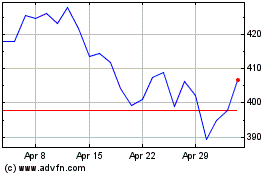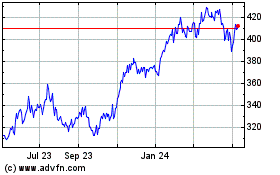Surface Studio First Look: Microsoft's All-in-One PC Aims High
October 26 2016 - 4:39PM
Dow Jones News
By Wilson Rothman
With the introduction of the Surface Studio all-in-one desktop
PC on Wednesday, Microsoft Corp. continued its push into high-end
hardware. The $2,999 machine's design features and build quality --
not to mention its specs -- appear to keep up with its sky-high
price.
We'll be putting the system through a full review soon, but our
first look, following its unveiling, was promising. And as much as
it looks like an iMac (and it is, indeed, an iMac competitor), it's
the differences that drew my attention.
In a world of thin LCD screens, this one didn't stand out as
much as the shiny chrome hinges that hold it up, and the tidy
little box it's connected to. Apple Inc. packs all of its
electronics into the iMac screen itself, relying on a heavy base to
keep it from tipping over. Microsoft is using the electronics as
ballast, so the system feels lighter but no less sturdy.
You can't just flip the screen backward. Instead, the hinges on
the base and the back of the LCD work in tandem. A gentle push on
the top of the screen brings the bottom forward, until the whole
screen comes to rest on the tabletop. Microsoft encourages you to
lean against it, as you would a drafting table. It's stable, and
the computer can recognize -- and ignore -- your arm as it rests
against the touch screen.
The display is beautiful, a 28-inch screen with a 4x3 aspect
ratio and over 13 million pixels. (By comparison, a 4K TV has just
over 8 million pixels, while Apple's 5K iMac has nearly 15 million
pixels.) The color gamut is tuned to meet the requirements of
photographers, illustrators and video producers who need to know
exactly how green their greens are. Needless to say, it's
vivid.
As a Surface, it's a touch screen, but it also responds to the
pen and a new product, called the Surface Dial. This accessory --
sold separately for $99 -- is both a wheel and a button: spin it or
press it. If you set it on a tabletop, you could adjust volume,
scroll through documents, zoom in and out of images and more,
depending on the app. (Microsoft says it's compatible with any
device that runs Windows 10 Anniversary Edition.)
But when you stick it on the Surface Studio's screen, the
computer recognizes it, and compatible apps can incorporate it as
an on-screen tool. In an architectural demo, when placed on a
blueprint, it became a zoom dial, but when it was moved to the
side, it immediately changed to a scroll wheel. Imagine a music
mixing board, where the producer places it on different parts of
the screen to instantly get subtle control over different channels
or effects.
As cool as it is, the Dial will appeal only to people whose
needs are so intense, they already know they want one. Writing and
drawing with a pen are slightly more mainstream activities, but
again, they're still mainly targeted at professionals who already
doodle on tablets. Since many of these right-brained types have
traditionally been on Macs, it isn't clear if there is enough here
to draw them out of Apple's universe, but Microsoft is certainly
making an argument.
For people who have long used Windows, and have been dying for
an excuse to put the wheezing old family PC out to pasture, this
represents a tantalizing, if spendy, upgrade opportunity. Microsoft
is confident in its appeal: It expects to sell out during the
holidays.
Write to Wilson Rothman at wilson.rothman@wsj.com
(END) Dow Jones Newswires
October 26, 2016 16:24 ET (20:24 GMT)
Copyright (c) 2016 Dow Jones & Company, Inc.
Microsoft (NASDAQ:MSFT)
Historical Stock Chart
From Mar 2024 to Apr 2024

Microsoft (NASDAQ:MSFT)
Historical Stock Chart
From Apr 2023 to Apr 2024
